What are tripod spikes?
Tripod spikes are a photographic support accessory designed to improve tripod stability on tricky terrain such as ice, mud, sand or snow. Made out of stainless steel, brass, aluminium or even titanium, they allow tripod legs to anchor into the slippery ground or to penetrate through a loose top layer. Tripod feet spikes come in different shapes and sizes to serve different purposes.
Spikes may be integrated into the tripod legs, or might be attached in place of removable rubber feet. Some higher end tripods ship bundled with spikes, while for others you might have to purchase them separately. Not every tripod can be equipped with spiked feet, many basic models come with rubber feet permanently fixed on.
What are the different types of tripod spikes?
There are a couple of different design approaches to equipping tripods with spikes. Which one your tripod’s manufacturer has opted for will determine how you use them. More sophisticated manufacturers like Gitzo offer all the different options for you to pick and choose. Let’s see what they are, starting with the most common:

Interchangeable feet
Most mid and high end tripod legs you get will feature interchangeable feet. They are used not only to give you the option of rubber or spiked feet, but also to let you exchange them when they wear down or get damaged. In addition, big manufacturers like Gitzo offer spikes of different length, which can be useful in certain situations.
The most common way of attaching tripod feet is via a standard 3/8″ thread. Most manufacturers share this design, so you can easily equip your tripod with new feet. Rubber feet usually provide enough of a grip to let you loosen and tighten them without any tools. Spikes, on the other hand, will require a spanner to be properly secured or removed. Suitable small spanners are usually included in spike feet sets, or just use your favourite adjustable wrench. Most spikes also come with holes through which you can slot a small rod (like a hex key or screwdriver) and use it to tighten or loosen the spike.
You will most likely want to remove spikes whenever you transport your tripod. Carrying a spiked tripod may be dangerous, both to others and to property. In addtion, sharp spikes will cut through most bags given enough time. Make sure you have a good system of packing away spikes and feet, as it’s easy to loose one in the field. ProMediaGear offer an elegant solution to this by making reversible spikes that fit inside the tripod legs while not in use.
Screw-type combination feet
Many lower end or older video tripods feature a 2-in-1 solution to the tripod foot conundrum. It comes in the shape of a spike, featuring a threaded section upon which a plastic or rubber knob rides. The knob can be turned to expose or cover the spike, thus providing an easy and quick change.
This feature can be retrofitted on some interchangeable feet tripods. Gitzo, for example, offer a set called the Video Rubber and Spike feet that can be installed on their Series 2 or higher. They are attached using the standard 3/8″ thread, so any tripod or monopod using this thread standard for it’s interchangeable feet can be fitted with them.
The benefits of this system are obvious: a quick, tool-less change between spikes and rubber might just be what was missing in your workflow. However, users report decreased stability when using the rubber mode, especially if you do not make sure to extend and tighten the knobs all the way down. There is also the risk of scratching a floor, should one of the knobs ride up on the spike without you noticing.
In addition, the larger diameter of the knobs may limit the usability of the spikes, especially in softer ground. Furthermore, this design is a bit more troublesome in terms of maintenance. Dust or sand will eventually find itself into the threads, and then you will have a stuck foot on your hands.
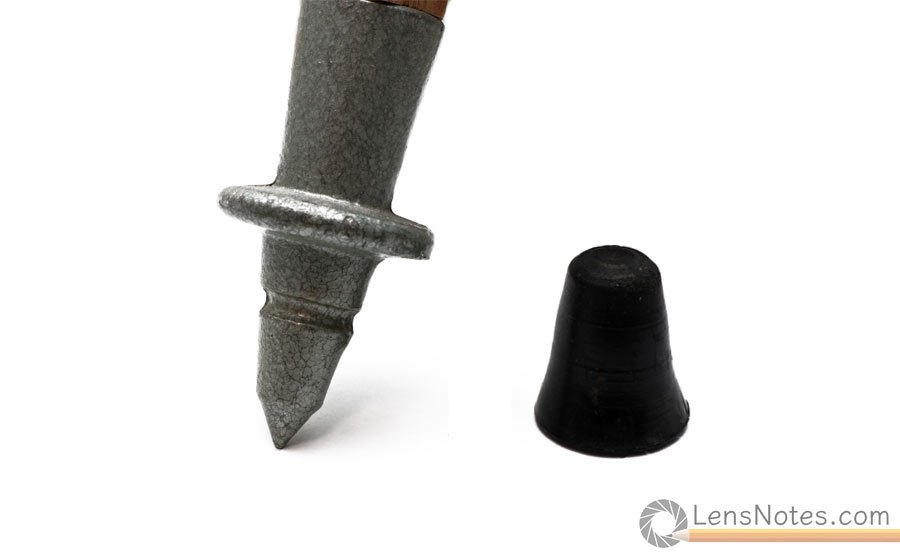
Rubber cap combination feet
Another approach to combining spiked and rubber feet into one is to cover spikes with removable rubber boots. The spikes themselves might be removable, or, like on the vintage wooden tripod leg pictured above, fixed. The rubber caps may be friction fitted or threaded, with the latter being a better option, providing a more stable and secure fit. This design is often found on wooden tripods, both vintage and current models from the likes of Berlebach and Ries.
This might look like a best of both worlds solution, as it allows you quick, tool-less changes between spikes and rubber feet. That is, until you lose one of the rubber covers, rendering your tripod all but unusable on any surface you don’t want to scratch up. If you are lucky, you will just have to wait for a spare. If not, you might have to hit the cane tip bucket at the local pharmacy hoping to find a suitable replacement or improvise with some self-fusing tape.
When are tripod spikes used?
The most important question of all. If you are just got your new tripod bundled with some spikes, you might ask yourself: “Where do I use these?”. Actually, as with most things in photography, there are no set rules, and no right answer. The decision to use tripod spikes will come from a particular set of circumstances, combined with experience and/or a trial and error process. There are several typical situations in which you might consider using spikes:
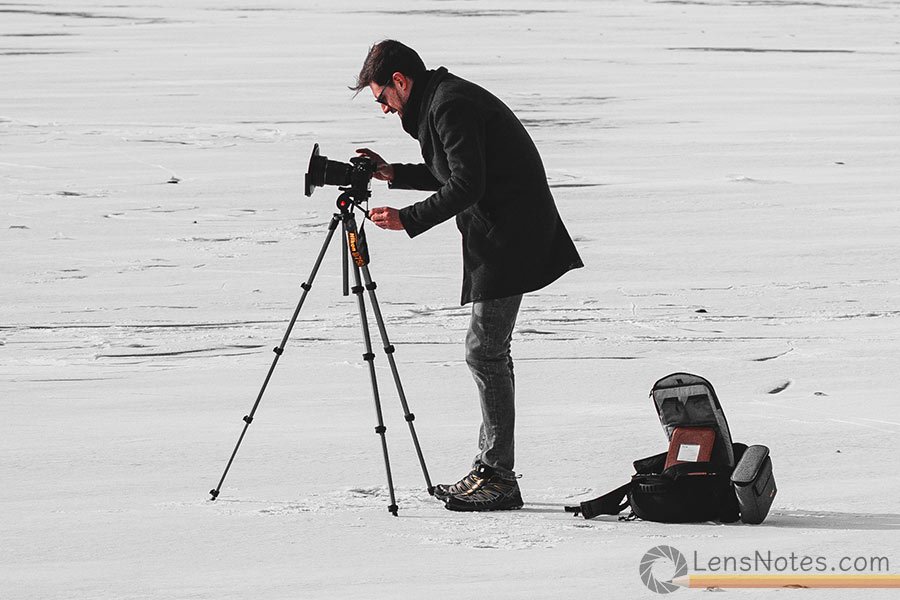
Ice
Shooting on ice is perhaps the most clear-cut tripod spike situation you are going to get. If you’ve ever set your rubber feet tripod up on an icy spot, you know it’s pretty easy to slide it around with even the slightest adjustment. Snapping away single shots, it might not be a problem. If, however, you are shooting anything that requires repeatability or multiple exposures, you’re screwed. HDR, panoramas or anything but locked-off video are some examples where increased stability is desired.
Rough, snowed over ice might just have a bit of texture in which to lodge rubber feet, but a flat, freshly frozen spot is pretty unforgiving. Regardless of what rubber your tripod feet are made of, the chance of them gripping on sleek ice are slim to none. Sharp spikes, on the other hand, will easily grab and hold onto the sleekest of ice patches.
Mud / Sand / Loose dirt
Shooting on a messy or loose terrain might be another situation where tripod spikes may prove beneficial. However, using spikes in the mud or sand is a bit different than on the ice. On ice the sharp spikes dig into the hard surface to prevent slipping.
But what if there’s no hard surface in sight? On soft, loose terrain pointy spikes help you drive the tripod legs depper, thus anchoring the tripod down. If you find yourself working on such terrain often, you might look into longer spikes that fascilitate this process better. In addition, long spikes protect your tripod better, as they eliminate the need to drive the leg itself into the ground. This makes them particularly suited to seaside photography, for example.
Be careful if you are using long spikes with a carbon fiber tripod. The forces involved into driving the leg into the ground combined with the increased leverage of the long spike may be enough to cause damage.

Rocks & Water
A rocky terrain is may be another good candidate for the tripod spike treatment. In particular, slippery, wet rocks, may prove challenging to navigate with rubber tripod feet. As opposed to soft ground, long tripod spikes have no advantage on the rocks, and in fact may make your tripod less stable due to the increased leg length. Short, stubby spikes are perfect for rocky terrain.
Any time water is involved, rubber tripod feet are bound to loose a lot of their grip. Depending on the surface you are working on, spikes will generally have a much greater chance of staying in place when wet, unless you are dealing with something like glass or polished marble. In a situation like the one pictured above, spiked tripod feet will certainly help you achieve better stability.

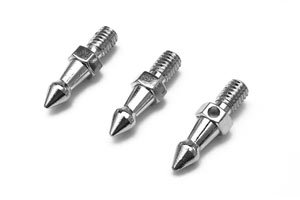
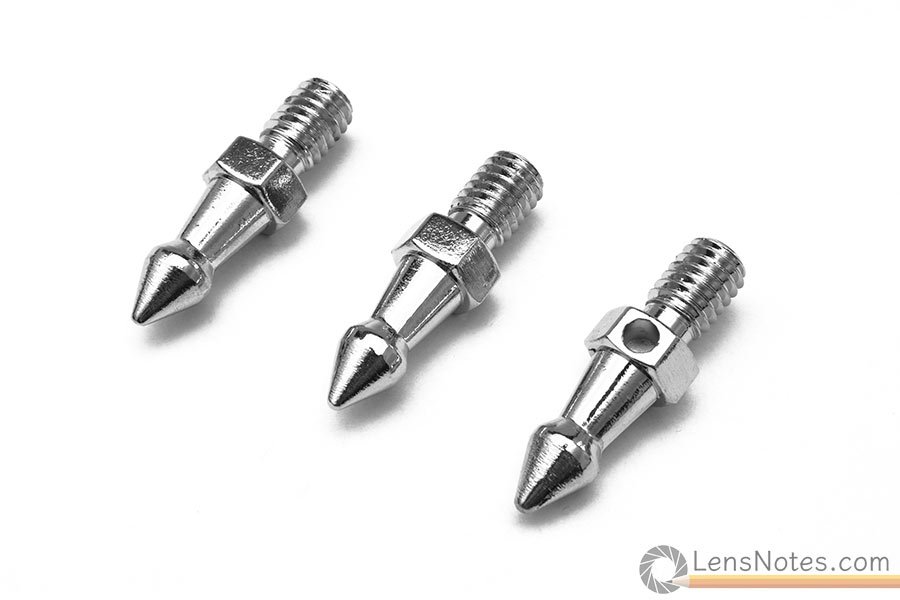

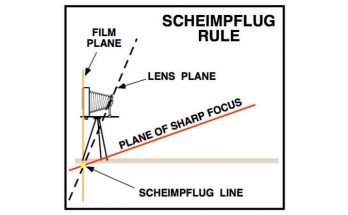

I was looking for it. Thanks for the informative article.